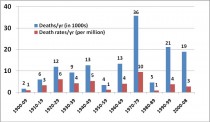By Indur M. Goklany
Background
Based on 2000-08 data, extreme weather events are responsible for about 0.05% of all global deaths (31,700 deaths vs. 58.8 million, annually). That is, despite the media attention to such events, extreme weather events have a minor impact on global public health.
Long term (1900-2008) data show that average annual deaths and death rates from all such events declined by 93% and 98%, respectively, since cresting in the 1920s (Figure 1). These declines occurred despite a vast increase in the populations at risk and more complete coverage of extreme weather events (Figure 2).

Figure 1: Enlarged here. Global Death and Death Rates Due to Extreme Weather Events, 1900-2008. Source: Goklany (2009), based on EM-DAT (2009), McEvedy and Jones (1978), and WRI (2009).

Figure 2: Enlarged here. Average Number of Extreme Weather Events per Year by Decade, 1900-2008. Source: Goklany (2009), based on EM-DAT (2009).
Deaths and death rates from droughts were responsible for the majority (58%) of all deaths due to extreme weather events from 1900-2008. They also peaked in the 1920s. Since then, they have been reduced by 99.97% and 99.99%, respectively (Figure 3).

Figure 3: Enlarged here. Droughts: Global Deaths & Death Rates, 1900-2008. Source: Goklany (2009), based on EM-DAT (2009), McEvedy and Jones (1978), and WRI (2009).
For floods, responsible for another 34% of aggregate deaths, deaths and death rates have declined by 98.7%-99.6% since the 1930s (Figure 1).

Figure 4: Enlarged here. Floods: Global Deaths and Death Rates, 1900-2008. Source: Goklany (2009), based on EM-DAT (2009), McEvedy and Jones (1978), and WRI (2009).
For storms (including hurricanes, cyclones, tornados, typhoons), responsible for 7% of extreme weather event deaths from 1900–2008, deaths and death rates declined by 47.0%-70.4% since the 1970s (Figure 4).

Figure 5: Enlarged here. Storms (including hurricanes, cyclones, tornados, typhoons): Global Deaths and Death Rates, 1900-2008. Source: Goklany (2009), based on EM-DAT (2009), McEvedy and Jones (1978), and WRI (2009).
These trends indicate that the total risk of death from all extreme weather events has actually declined despite claims that the number and intensity of extreme weather events has increased. The decline in deaths from extreme weather events occurred despite an increase in deaths from all causes, indicating that the world is coping with the former much better than it is with far more significant sources of deaths and disease. What accounts for the reduction in the death toll from extreme weather events?
First, the decline in the death toll from droughts, in particular, is that global food production has never been higher than it is today (Goklany 1998, 2007). This is largely due to improved seeds, fertilizers, pesticides, irrigation, and farm machinery. This entire suite of technologies also enabled the Green Revolution. But fertilizers and pesticides are manufactured from fossil fuels, and energy is necessary to run irrigation pumps and machinery. Without them, the benefits of improved seeds would be for naught. And in today’s world, like it or not, energy for the most part is synonymous with fossil fuels.
The resulting increase in yields and food production helped reduce food prices worldwide which reduced hunger by making food more affordable (Goklany 2007). Additional CO2 in the atmosphere has also contributed to higher yields and food production (IPCC 2001: 254–257, 285) because it provides carbon, the basic building block of life, and also increases the efficiency with which plants use water helping offset declines in water availability, if any.
Another factor critical to reining food prices and reducing hunger worldwide is trade within and between countries which enables food surpluses to be moved to food deficit areas (Goklany 1995, 1998). But it takes fossil fuels to move food around in the quantities and the speed necessary for such trade to be an integral part of the global food system, as it indeed is. Moreover, fossil fuel dependant technologies such as refrigeration, rapid transport, and plastic packaging, ensure that more of the crop that is produced is actually eaten by the consumer. That is, they increase the overall efficiency of the food production system, which helps lower food prices and contain hunger worldwide.
The second important factor is better disaster preparedness, and more rapid response and delivery of humanitarian aid when disaster strikes. Timely preparations and response are major factors that have contributed to the reduction in death and disease that traditionally were caused by or accompanied disasters from extreme weather events (Goklany 2007b). Their success hinges on the availability of fossil fuels to move people, food, medicine and critical humanitarian supplies before and after events strike. Economic development also allowed the US (and other developed countries) to offer humanitarian aid to developing countries in times of famine, drought, floods, cyclones, and other natural disasters, weather related or not. Such aid, too, would have been virtually impossible to deliver in large quantities or in a timely fashion absent fossil fuel fired transportation.
These improvements, which occurred despite increases in the populations at risk, can be attributed largely to the combination of greater economic development and technological change. Together they enable society to protect against - and cope with - adversity in general, and extreme weather events in particular (IPCC 1991; Goklany 1995, 2007).
The role of economic development in reducing the death toll from natural disasters is confirmed by analyses undertaken by Kahn (2005) and van der Vink et al. (2007). Kahn’s analysis of natural disasters for 73 nations from 1980-2002 found that an average nation with a population of 100 million and GDP per capita of $2,000 would in 1990 have experienced 944 deaths from natural disaster, however, had GDP per capita been raised to $14,000, its death toll would have fallen to 180 per year, an 81% decline (p. 280). Although both studies covered weather and non-weather related disasters, their findings should be generally applicable to all types of natural disasters, whether weather related (or not). Both also found that nations that were less democratic and scored lower on measures of good governance suffered a higher death toll. Kahn also concluded that greater income inequality led to higher death tolls.
These findings are generally consistent with recent experience on natural disasters. For instance, while no two disasters are alike in terms of risk and population exposure, it is notable that an estimated 222,600 people died in the 7.0 magnitude Haiti earthquake in January 2010, while the death toll from the much-stronger 8.8 magnitude Chilean earthquake that occurred the following month killed fewer than 600 people (EM-DAT 2010). Similarly, in 2008, Cyclone Nargis, with a maximum intensity of 115 knots, killed 138,400 in Myanmar while Cyclone Sidr - maximum intensity, 140 knots - killed 4,240 in Bangladesh (JWTC 2007, 2008; EM-DAT 2010).
Finally, over the long term, despite population increases, cumulative mortality from extreme weather events has declined globally, even as total (all-cause) mortality continues to increase. That is, humanity is coping better with extreme weather events than with far more important health and safety problems.
Resources spent to reduce global warming are better spent elsewhere
Currently many advocate spending trillions of dollars to reduce anthropogenic greenhouse gases, in part to forestall hypothetical future increases in mortality from global warming induced increases in extreme weather events. Spending even a fraction of such sums on the numerous higher priority health and safety problems plaguing humanity would provide greater returns for human well-being (Goklany 2009a, 2009b). No less important, efforts to reduce greenhouse gas emissions would slow, if not retard, economic development and/or make fossil fuels scarcer and more expensive thereby militating against the very factors that have reduced deaths and death rates from extreme weather events.
Summary
Whether the magnitude or frequency of extreme weather events has increased because of global warming is not evident from long term data on deaths and death rates from extreme weather events. In any case this issue is secondary to the fact that casualties from all such events have been reduced by over an order of magnitude in the past decades. These reductions are due in large part to factors that contribute to greenhouse gas emissions.
Reducing these emissions through efforts to make fossil fuel energy scarcer and more expensive could, therefore, be counterproductive in humanity’s efforts to limit death and disease from not only such events but also other, far more significant sources of adversity.
About the author
Dr. Indur M. Goklany is a member of the GWPF Academic Advisory Council. He is an author and a researcher who has been associated with the Intergovernmental Panel on Climate Change since its inception in 1988 as an author, expert reviewer, and U.S. delegate to that organization.


